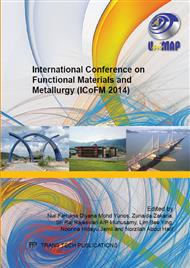[1]
Lyckfeldt, E. Lidén, R. Carlsson, Processing Thermal Insulation Materials with Controlled Porosity, in D.P. Stinton, S.Y. Limaye (Eds. ), Ceramic Transactions, Low Expansion Materials, 52, The American Ceramic Society, Westerville, (1995).
Google Scholar
[2]
N.A. Vladimir, Foam Ceramic Filters for Molten Metals: Reality and Prospects, Powder Metall. Metal Ceram., 42 (2003) 474-476.
DOI: 10.1023/b:pmmc.0000013219.43559.46
Google Scholar
[3]
M.V. Twigg, J.T. Richardson, Fundamentals and Applications of Structured Ceramic Foam Catalysts, Ind. Eng. Chem. Res., 46 (2007) 4166-4177.
DOI: 10.1021/ie061122o
Google Scholar
[4]
I. Sopyan, J. Kaur, Preparation and Characterization of Porous Hydroxyapatite Through Polymeric Sponge Method, Ceram. Int. 35 (2009), pp.3161-3168.
DOI: 10.1016/j.ceramint.2009.05.012
Google Scholar
[5]
W.H. Chan, M.N. Mazlee, Zainal A. Ahmad, J.B. Shamsul, M.A.M. Ishak, M.S. Jusoh, Adv. Mater. Res. 795 (2013), pp.96-101.
Google Scholar
[6]
K. Schwartzwalder and V.S. Arthur, U.S. Patent 3, 090, 094 (1963).
Google Scholar
[7]
H. Wang, I.Y. Sung, X.D. Li, D.P. Kim, Fabrication of Porous SiC Ceramics with Special Morphologies by Sacrificing Template Method, J. Porous Mater. 11, (2004), pp.265-271.
DOI: 10.1023/b:jopo.0000046353.24308.86
Google Scholar
[8]
A.R. Studart, U.T. Gonzenbach, E. Tervoot, L.J. Gauckler, Processing Routes to Macroporous Ceramics: A review, J. Am. Ceram. Soc. 89 (2006), pp.1771-1789.
DOI: 10.1111/j.1551-2916.2006.01044.x
Google Scholar
[9]
B. Zora, P. Ladislav, L. Ján, K. Vladimír, Properties of Al2O3 Foams Optimized by Fractional Design, Ceramics – Silikáty 55 (2011), pp.240-245.
Google Scholar
[10]
J.H. Lee, H.J. Choi, S.Y. Yoon, B.K. Kim, H.C. Park, Porous Mullite Ceramics Derived from Coal Fly Ash using a Freeze-Gel Casting/Polymer Sponge Technique, J. Porous Mater. 20 (2013), pp.219-226.
DOI: 10.1007/s10934-012-9591-0
Google Scholar
[11]
P. Sultana, S. Das, A. Bhattacharya, R. Basu, P. Nandy, Mullite Formation in Coal Fly Ash is Facilitated by the Incorporation of Magnesium Oxide, Rev. Adv. Mater. Sci. 27 (2011), pp.69-74.
Google Scholar
[12]
W.Y. Kim, H.B. Ji, T.Y. Yang, S.Y. Yoon, H.C. Park, Preparation of Porous Mullite Composites through Recycling of Coal Fly Ash, J. Korean Ceram. Soc. 47 (2010), pp.151-156.
DOI: 10.4191/kcers.2010.47.2.151
Google Scholar
[13]
J.M. Lee, T.Y. Yang, S.Y. Yoon, B.K. Kim, H.C. Park, Recycling of Coal Fly Ash for Fabrication of Porous Mullite Composites, Adv. Mater. Res. 156-157 (2011), pp.1649-1652.
DOI: 10.4028/www.scientific.net/amr.156-157.1649
Google Scholar
[14]
D.M. Dabbs, N. Yao, I.A. Aksay, Nanocomposite Mullite/Mullite Powders by Spray Pyrolysis, J. Nanopart. Res. 1 (1999), pp.127-130.
Google Scholar
[15]
C.Y. Chen, G.S. Lan, W.H. Tuan, Preparation of Mullite by the Reaction Sintering of Kaolinite and Alumina, J. Europe Ceram. Soc. 20 (2000), pp.2519-2525.
DOI: 10.1016/s0955-2219(00)00125-4
Google Scholar
[16]
W.M.N. Nour, H.M. Awad, Effect of MgO on Phase Formation and Mullite Morphology of Different Egyptian Clays, J. Aust. Ceram. Soc. 44 (2008), pp.27-37.
Google Scholar
[17]
J. Anggono, Mullite Ceramics: Its Properties, Structure and Synthesis, Jurnal Teknik Mesin, 7 (2005), pp.1-10.
Google Scholar
[18]
Y. Hwang, H.S. Lee, W.C. Lee, Preparation of Low Density Ceramic Support from Coal Fly Ash, Geosystem, 4 (2001), pp.117-122.
DOI: 10.1080/12269328.2001.10541175
Google Scholar
[19]
A. Namiranian, M. Kalantar, Mullite Synthesis and Formation from Kyanite Concentration in Different Conditions of Heat Treatment and Particle Size, Iran J. Mater. Sci. Eng. 8 (2011), pp.29-36.
Google Scholar


